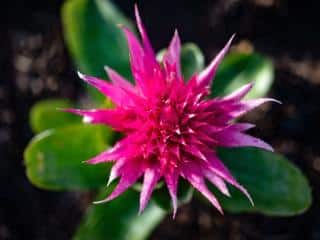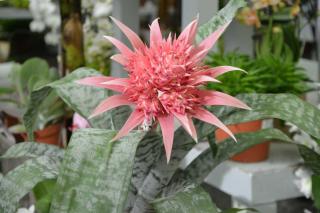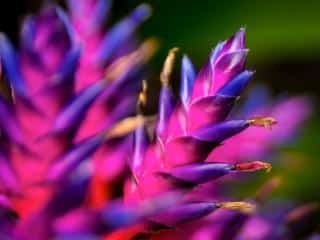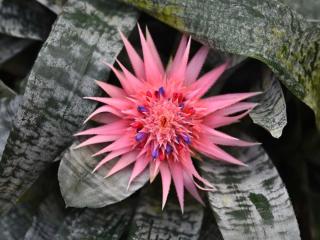

Original, colorful and exotic: Aechmea is a simply astounding indoor plant.
Main Aechmea facts
Name – Aechmea
Family – Bromeliaceae
Type – indoor plant
Height – 12 to 20 inches (30 to 50 cm)
Exposure – bright but not direct light
Foliage: evergreen – Flowering: end of winter or summer
Native to Central and South America, this bromeliad has mottled foliage and beautiful pastel red blooming that are very appealing.
Aechmea, like all other Bromeliaceae plants, requires soil that is sufficiently rich and very well-drained to grow well.
 Special Bromeliaceae soil mix is the best solution. Luckily, you can also go for flower plant soil mix and layer the bottom of the pot with a thick drainage medium.
Special Bromeliaceae soil mix is the best solution. Luckily, you can also go for flower plant soil mix and layer the bottom of the pot with a thick drainage medium.
If you wish to repot your aechmea, wait for the blooming to end.
The best location for your aechmea is in a spot where there isn’t any direct sun on the plant.
 Your aechmea can’t stand the sun’s rays when they touch its leaves directly.
Your aechmea can’t stand the sun’s rays when they touch its leaves directly.Aechmea requires temperatures that oscillate between 65 and 74°F (18 to 24°C) and never drop below 57°F (-13°C).
The temperature of a house or apartment is thus ideal for growing your aechmea.
Regular but moderate watering is called for because Aechmea doesn’t usually require a lot of water.
Keep the soil mix barely moist and check that water drains properly.
 Provide orchid-specific fertilizer more or less once a month to extend the blooming as long as can be.
Provide orchid-specific fertilizer more or less once a month to extend the blooming as long as can be.
To retain a certain moisture level, it is best to put the pot atop a bed of clay pebbles or little stones wallowing in water. Evaporation will help recreate the living environment of their native habitat without needing to overwater.
Limit the watering and wait for the soil to be thoroughly dry before watering again.
Most diseases targeted are commoon indoor plant diseases, red spider mites, scale insects, aphids and also powdery mildew.
 Aechmea is a beautiful bromeliad, and it’s also probably the easiest of all to care for. Once you’ve gone through its lifecycle, you’ll enjoy each step of it:
Aechmea is a beautiful bromeliad, and it’s also probably the easiest of all to care for. Once you’ve gone through its lifecycle, you’ll enjoy each step of it:
A famous variety is Aechmea fasciata, which is commonly called the “urn plant”.
Read also:
Did you know that indoor plants can cleanse the air of pollutants?
A fabulous indoor plant, aechmea is native to tropical forests and is rendered vulnerable by the dry air in our homes.
Spraying the plant regularly and placing the pot atop a bed of wet gravel will help re-create the plant’s natural habitat.